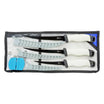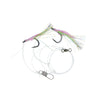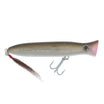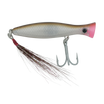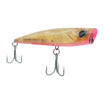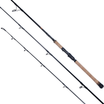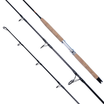Albie fishing, also known as fishing for false albacore, can be both challenging and rewarding. In the video "Albie Fishing 101: Hogy Albie Playbook," Captain Mike shares his expertise and techniques for a successful albie fishing trip. This article summarizes the key points from the video, providing valuable insights for anglers of all skill levels.
●Contents of This Video●
0:00 Intro
01:00 Approaching schools of fish
01:45 Walk n' Gun technique
02:57 Hooked up!
05:24 Making Drifts technique
05:57 Run n' Gun technique
06:50 When to use a Hogy Slowtail
07:45 Color choices
09:01 Hooked up!
10:15 Attractor colors in action
11:38 How to fish Hogy Epoxy Jigs
14:40 Crimping barbs
15:52 How to fish metals
16:49 Understanding albies
18:07 How to fish plugs
18:58 Pop n' Fly technique
19:58 The Hogy Albie System
27:05 Outfit
29:58 Takeaway
Preparation and Gear
Essential Gear
To begin with, having the right gear is crucial for albie fishing. Captain Mike recommends a seven-foot inshore rod paired with a 5000-class reel. The ideal setup includes 20-pound test braid and a 15-pound fluorocarbon leader. This combination offers the strength needed to handle albies while ensuring good casting distance and sensitivity.
Lure Selection
A variety of lures should be part of any angler's arsenal. The video emphasizes the importance of having both attractor and imitator colors. Attractor colors are bright and designed to catch the fish's attention, while imitator colors mimic the baitfish albies are feeding on. Here are some of the lures mentioned in the video:
Peanut Bunker Jig: A jig designed to mimic peanut bunker baitfish, featuring a wobble built into its design.
Hogy Epoxy Jig Lure: A light lure that can be used for various retrieves including skipping and high-speed retrieves. A versatile lure that can be fished fast or slow, with a translucent body that reflects light naturally.
Heavy Minnow Jig: A dense, metal jig ideal for long-distance casting, especially effective in windy conditions.
Hogy Slow Tail: A soft bait with a twin tail design that offers a lot of action at slow retrieve speeds.
Clear Popper: Used in combination with a small fly, ideal for creating commotion and attracting fish, especially in calm conditions.
Hogy Pro Tail Fly: A small fly that mimics tiny baitfish, often used with a clear popper.
Amber Popper: A small plug that creates popping action, useful for calling in fish on calm days.
Hogy Slider: A larger plug that can be used for blind casting when fish are scattered, offering greater visibility and attraction.
Finding and Approaching Fish
Utilizing Resources
Networking and utilizing resources can significantly increase your chances of finding albies. Captain Mike received a tip from Captain Terry Nugent, which led him to a large school of albies. Such information can be invaluable, especially early in the season.
Slow and Steady Approach
When approaching a school of albies, a slow and steady approach is essential. Charging in can spook the fish, making them difficult to catch. Instead, idling along and observing the fish's behavior allows for better positioning and more successful casts.
Fishing Techniques
The Walking Gun Technique
Captain Mike introduces the "Walking Gun" technique, which involves idling along slowly and keeping an eye out for fish. This method contrasts with the traditional "Run and Gun" approach, which involves rapidly moving to schools of fish. The Walking Gun technique helps avoid spooking the fish with sudden RPM changes and boat noise.
Different Retrieves
Understanding and mastering different retrieves can make a significant difference in your catch rate. The video outlines three primary retrieves:
Skippy Retrieve: Simulates a fleeing baitfish by skipping the lure along the surface.
High-Speed Retrieve: Burns the lure through the water just below the surface, ideal for attracting fast-moving fish.
Slow Retrieve: Provides a natural swimming action, perfect for when fish are more finicky.
Observing Patterns and Behavior
Recognizing Patterns
Observing the fish's patterns and adjusting your strategy accordingly is key. Albies often run in specific directions based on factors like tide and wind. By paying attention to these patterns, anglers can anticipate where the fish will appear next.
Impact of Boat Noise
Boat noise and sudden RPM changes can spook albies. Maintaining a steady speed and minimizing noise can help keep the fish around longer, increasing the chances of a successful catch.
Color Selection
Attractor and Imitator Colors
Color selection plays a critical role in albie fishing. Captain Mike explains the importance of using both attractor and imitator colors in your lures:
Attractor Colors: These are bright and designed to catch the fish's attention. Examples include hot pink and other vibrant hues that stand out in the water. Attractor colors are particularly useful when there is a lot of bait in the water, and you need your lure to be noticed.
Imitator Colors: These colors mimic the natural baitfish that albies feed on. Common imitator colors include silver, olive, green, and natural baitfish patterns like peanut bunker, bay anchovies, and squid. Matching the hatch with imitator colors increases the likelihood of a bite as the fish are more likely to be attracted to familiar-looking prey.
Switching Colors
Having a mix of both types of colors in your tackle box is essential. It's important to observe the fish's behavior and preferences on any given day. Sometimes albies may prefer bright attractor colors, while other times they might go for more natural imitator colors. By starting with a variety of lures, you can determine what works best and adjust accordingly.
Underutilized Techniques
Soft Baits and Plugs
While jigs are commonly used for albie fishing, soft baits and plugs can also be highly effective. Soft baits, like the Hogy slow tail, offer a lot of action at slow retrieve speeds. Plugs, such as clear poppers, can be used to create commotion and attract fish, especially on calm days.
Conclusion
Albie fishing requires a combination of the right gear, techniques, and strategies. By following the tips and methods outlined in the "Albie Fishing 101: Hogy Albie Playbook" video, anglers can improve their chances of success. Whether it's utilizing resources, mastering different retrieves, or observing fish behavior, each element plays a crucial role in a successful albie fishing trip.




















